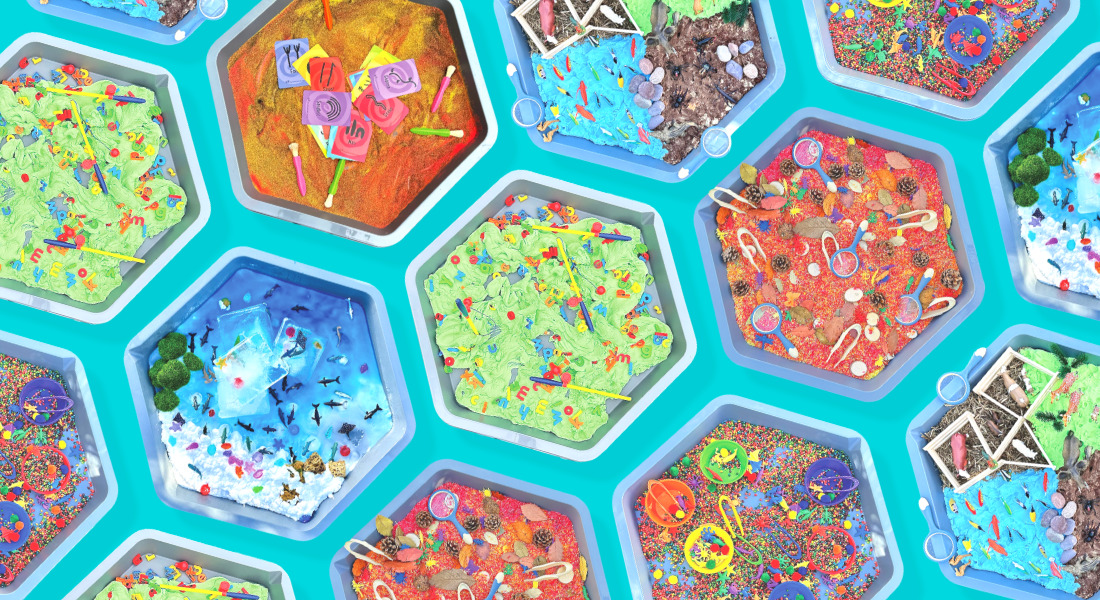Bring on the tray play! Versatile, engaging hex trays give children endless learning possibilities. Also known as a tuff tray or sensory table, the humble hex tray is an open-ended, moulded plastic tray typically in a natural sand colour with a hexagonal shape inspired by the shape of honeycomb (you can also get a charcoal hex tray).
Why tuff trays are a crowd favourite
These trays are great for both indoor and outdoor use. (Our ‘hex tray’ features UV-stable plastic which is fade resistant). Use it on a tabletop, on the floor or with a metal stand. Add playmats (textures, roadway, rainbow, chalkboard) or bring your own imagination to the table!!! Self-contained hex trays make the perfect platform for messy play, small world play, sensory exploration and nature play. We’re looking at sensory exploration in this blog as it’s such an important part of early childhood development, allowing children to explore using their senses of touch, sight, smell, hearing and sometimes taste! Hex trays are ideal for creating sensory experiences due to their shallow compartments and ability to contain various materials including water (keep a towel or two handy)! Let’s dive into our sensory activities.
Explore the deep blue sea
Transform your tray into a mini underwater world. Some important days in the calendar give you a great reason to make a splash! World Reef Awareness Day on 1st of June is focused on protecting the world’s coral reefs. Then World Oceans Day will be celebrated on 7th of June this year to raise awareness about the critical role our oceans play in sustaining life on Earth. These days give you a wonderful opportunity to teach about our world’s shared oceans and our personal connections to the sea. Fill compartments with blue-tinted water, add sea creatures, shells and stones. Encourage children to explore marine life, discuss ocean habitats and learn about sea creatures’ characteristics. Introduce concepts of buoyancy, sink and float, and understanding of the marine ecosystem.
Activity 1: Sensory ocean tray
In this messy play experience, we combine small world wonder with elements of STEM magic.
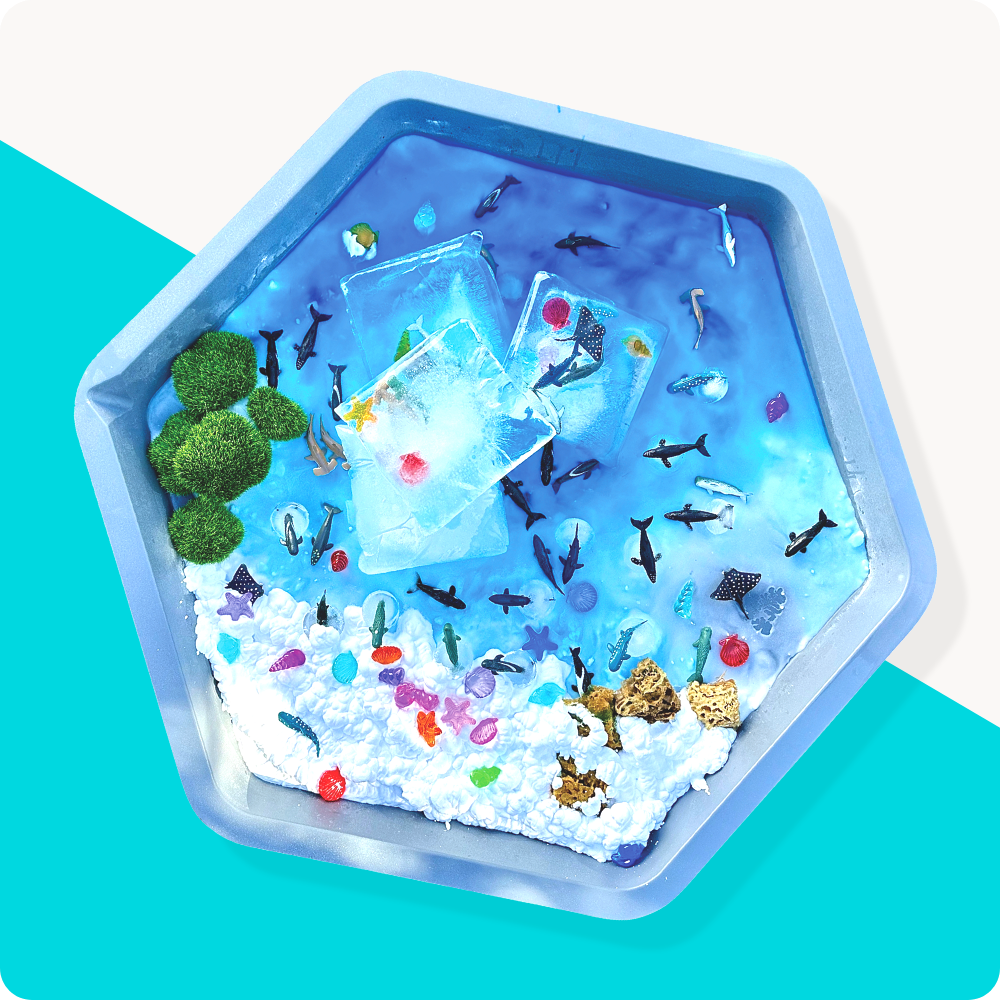
You’ll need:
Plastic Slip Syringe (SER1016003)
Zip lock bags (sandwich size)
Muffin pan or freezer-safe bowls
Shaving Foam
Bicarbonate of soda
Vinegar
Let’s make it!
- Add a few ocean counters to a zip lock bag and fill with water. Secure tightly and lay flat in the freezer until frozen solid. Repeat for desired quantity.
- Add ocean counters to a muffin pan (or bowl) and fill each section with water. Carefully place in a freezer until frozen.
- Shake 2 x 1kg boxes of bicarbonate of soda into the hex tray.
- Time to set the scene! Arrange the transparent shells, remaining ocean counters and grassy stones in the hex tray.
- Remove the muffin pan from the freezer and let sit for several minutes; the ice shapes should slip out easily now, and to the hex tray scene.
- Remove the frozen sandwich bags from the freezer, carefully remove the bag from the ice, discard the bag safely and add the ice bricks to the hex tray scene.
- Add a splash of blue craft dye to a jug of water and gently pour into the hex tray over the bicarbonate of soda.
- Add desired amount of shaving foam into the hex tray.
- Add a few cups of vinegar (we used double strength) into a bowl accessible for children to fill syringes with and squirt into the water. Done! You’re ready to explore.
TOP TIP – If you’re enjoying this messy play experience indoors, keep a towel nearby for quick clean ups as the morning/afternoon progresses.
Celebrate World Environment Day
This event on the 5th of June has become the largest global platform for environmental outreach. Join the movement! Use your hex tray to explore climate, weather patterns, global warming, animal habitats, marine pollution, overpopulation, sustainable development, wildlife and plant life. Create a miniature landscape representing different climates, from deserts to rainforests. Use natural materials like sand, moss and small plants to illustrate ecosystems. Discuss the importance of preserving the environment and the role each child can play in conservation efforts.
Activity 2: Wonderful world sensory tray
Create a small world sensory tray with creatures great and small roaming the earth!
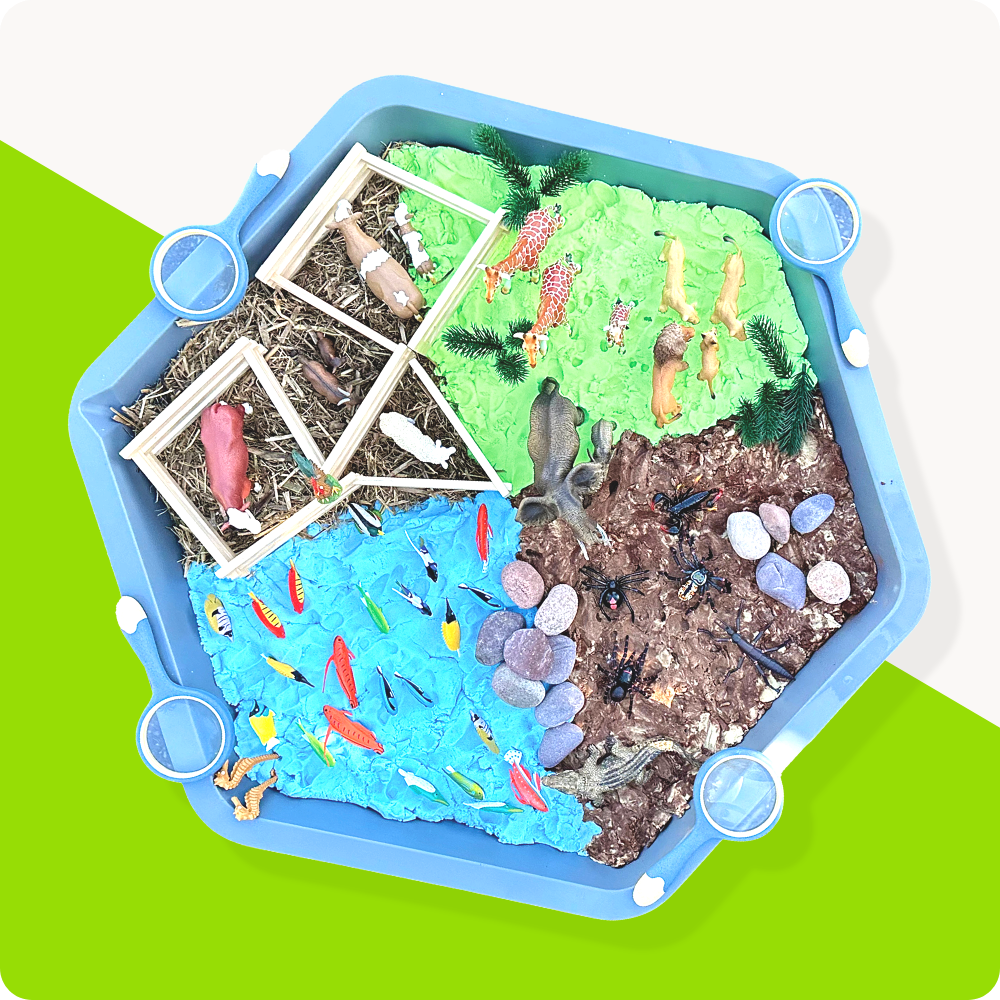
You’ll need:
All Weather Magnifying Glasses (GC4600)
Cocoa
Straw/hay
Let’s make it!
- To make the ‘soil’, add ½ cup of cocoa to the natural-coloured magic sand and give it a good mix through.
- Add all the different coloured sand and straw to the hex tray (we’ve sectioned the tray into wild animals, domesticated animals, ocean animals and insects, with each different coloured surface representing the land, sea, grass, and farm.
- Create a happy habitat by adding rocks and plants etc. to form a small world scene. Get creative! You might have some shells or flowers etc. on hand to add different colours, textures, and aromas.
- Carefully place the animals into their habitats along with magnifying glasses and you’re ready to play!
Extension:
Sensory Stories: Use your tray table as a storytelling prop for sensory narratives. Fill compartments with materials representing elements of a story about our world, such as cotton balls for clouds, blue water beads for the sea and small figurines for characters or animals. Encourage children to engage in imaginative play as they manipulate the sensory elements to retell the story or create their own narratives.
Sensory nature play
Using found objects in nature for sensory exploration is awesome, particularly in autumn and winter! Fill compartments with vibrant leaves of various shapes and colours. Encourage children to touch, feel and sort leaves based on texture, size and colour. Stimulate senses and promote descriptive language as children engage in tactile experiences with nature’s seasonal beauty. Explore the textures, scents and colours of each of nature’s treasures.
Activity 3: Nature sensory tray
Bold colours in autumn and winter offer an enticing invitation for children to explore.
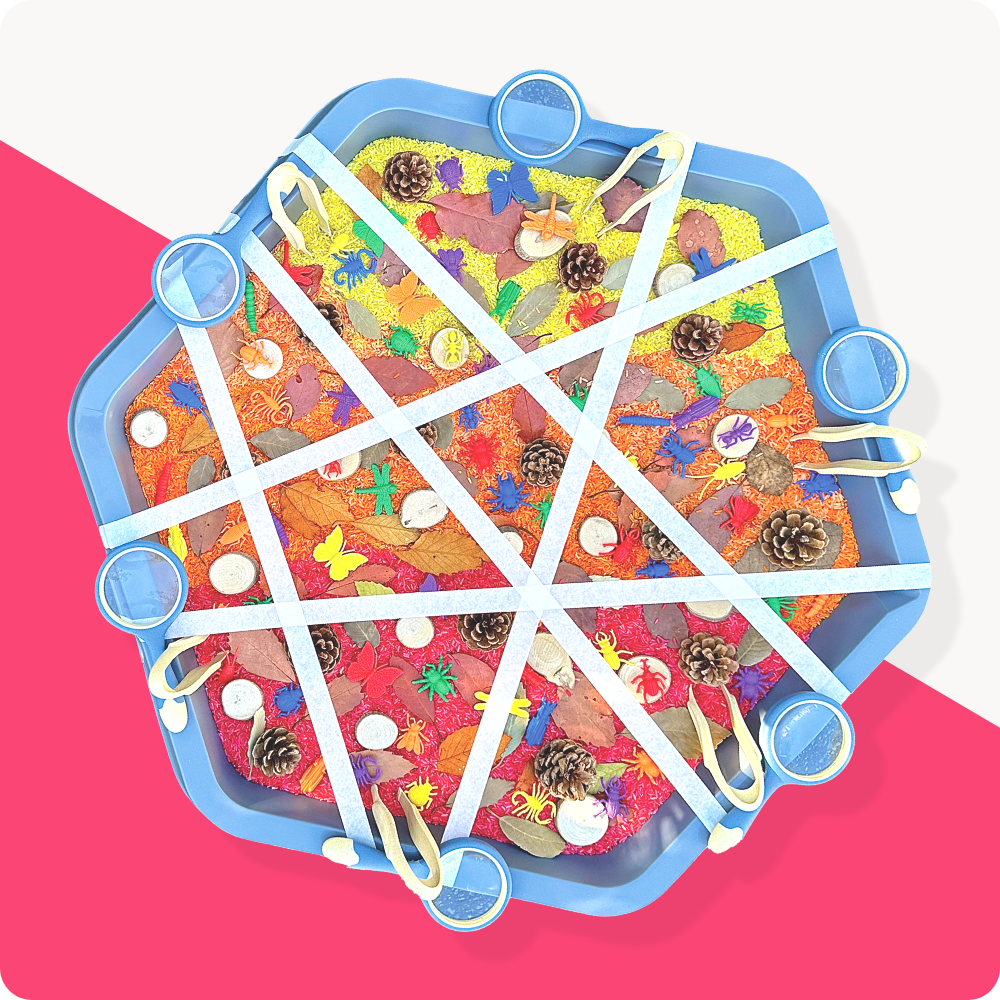
You’ll need:
5kg bag of white rice
Baking trays
Baking paper
Large zip lock bags
Branch circles
Pine Cones
Natural leaves
All-Weather Jumbo Tweezers (GC4604)
All-Weather Magnifying Glasses (GC4600)
Let’s make it!
- Add coloured rice to the bottom of the hex tray and decorate with the natural resources, leaves and insect counters.
- Adhere lengths of masking tape over the top of the tray, creating a maze for children to work through.
- Place a pair of tweezers, magnifying glass and paper cup at each station for children to search and collect objects. Done! You’re ready to explore.
How to colour rice:
- Add 4 cups of uncooked white rice to a large zip lock bag.
- Mix desired amount of vegetable dye powder with 1 tablespoon of vinegar and dump into the bag.
- Seal the bag well, then shake it around until the rice is coated in colour.
- Pour the coloured rice onto a baking tray lined with baking paper and spread out evenly.
- Leave to dry thoroughly for a day or so depending on the weather. To speed up drying time stir the rice around on the tray a few times to ensure air can access each grain as it dries, or place in the sun etc.
TOP TIP – If children are helping to shake the bag of coloured rice, it can be a good idea to double bag (place the sealed zip lock bag of rice into another zip lock bag and seal again).
Bring early literacy to life
Transform your hex tray into a literacy wonderland to support phonics and early reading skills. Fill compartments with letter tiles, phonics cards or literacy manipulatives. Engage children in hands-on activities to match letters, form simple words and explore letter-sound relationships. Encourage storytelling and imaginative play to enhance language development and literacy comprehension.
Activity 4: Alphabet fishing sensory tray
With this tactile activity, children will be reeling in their alphabet catch in no time.

You’ll need:
Cotton Sensory Sand 6kg (EC234-6)
Let’s make it!
- Tip the cotton sensory sand into the hex tray and spread evenly.
- Evenly spread desired number of magnetic letters over the sand.
- Place the fishing rods around the outside of the hex tray, inviting children to fish a letter. Done! You’re ready to explore.
TOP TIP – Younger children developing their hand eye coordination might enjoy working with magnetic wands to fish out the magnetic objects.
Colour sorting & sensory exploration
Use your tuff tray to introduce the concept of colour recognition and sorting. Fill compartments with an array of colourful objects such as buttons, beads or pom-poms. Prompt children to sort objects by colour, count each group and discuss colour shades and variations. Foster cognitive development and early mathematical concepts through hands-on colour exploration activities.
Activity 5: Colour sorting sensory tray
This tray activity combines tactile exploration with classification skills and fine motor dexterity.

You’ll need:
Sorting Bowls & Tweezers Set (TEB6332)
Popping corn
Jar/jug
Baking tray
Baking paper
Water
Vinegar
Measuring cups
Measuring spoons
Let’s make it!
- Add the coloured corn, pom poms and sea life counters to the hex tray.
- Place the matching Sorting Bowls & Tweezers around the 6 sides of the hex tray as ‘stations’ to invite children to collect the corresponding-coloured items. Done! You’re ready to explore.
TOP TIP – The vinegar coats the colouring onto the corn evenly and acts as a preservative to stop the corn from spoiling. It’ll last for ages! When you do finally finish, why not try sprouting the kernels in the veggie garden!
How to colour corn:
- Pour a 400g bag of popping corn into a large jar/jug (old coffee jars work well).
- Add 1 cup of water and 1 cup of vinegar (or 1/2 cup of double strength vinegar). Add a little more water if needed to completely cover the corn in liquid.
- Add 1 tablespoon of vegetable dye/food colouring to the jar and give it a good stir.
- Leave to soak for 24 hours, pour into a strainer, and give a good rinse under the tap (the coloured water can be used for painting if desired).
- Pour the corn onto a baking tray lined with baking paper and leave in a warm sunny spot to dry thoroughly (stir the corn around to ensure all surfaces are dry) and then store in an airtight container/zip lock bag until ready to use.
Extensions:
Texture Play: Fill compartments with a variety of textured materials such as colourful sand, rice, pasta, cotton balls or kinetic sand. Encourage children to explore the textures using their hands or even their feet for a more immersive experience. Discuss the differences between smooth, rough, soft and hard textures, fostering descriptive language and tactile awareness.
Calming activities: Create calming sensory experiences using soothing materials like lavender-scented rice, soft fabric scraps or water with a few drops of essential oil. Encourage children to engage in calming activities such as running their fingers through the rice or feeling the texture of the fabric, promoting relaxation and emotional regulation.
Exploring pre-writing & First Nations symbols
Activities that explore cultural perspectives are fantastic to incorporate into your tray time. Fill compartments with symbolic items like animal figurines, traditional artwork or Indigenous symbols. Encourage children to explore the significance of each symbol, engage in storytelling inspired by Indigenous culture and practise pre-writing skills by tracing symbolic patterns. Develop fine motor skills and cultural appreciation in an inclusive learning environment.
Activity 6: First Nations symbols sensory tray
This activity combines fine motor skills development with the exploration of literacy using Aboriginal symbols cards.
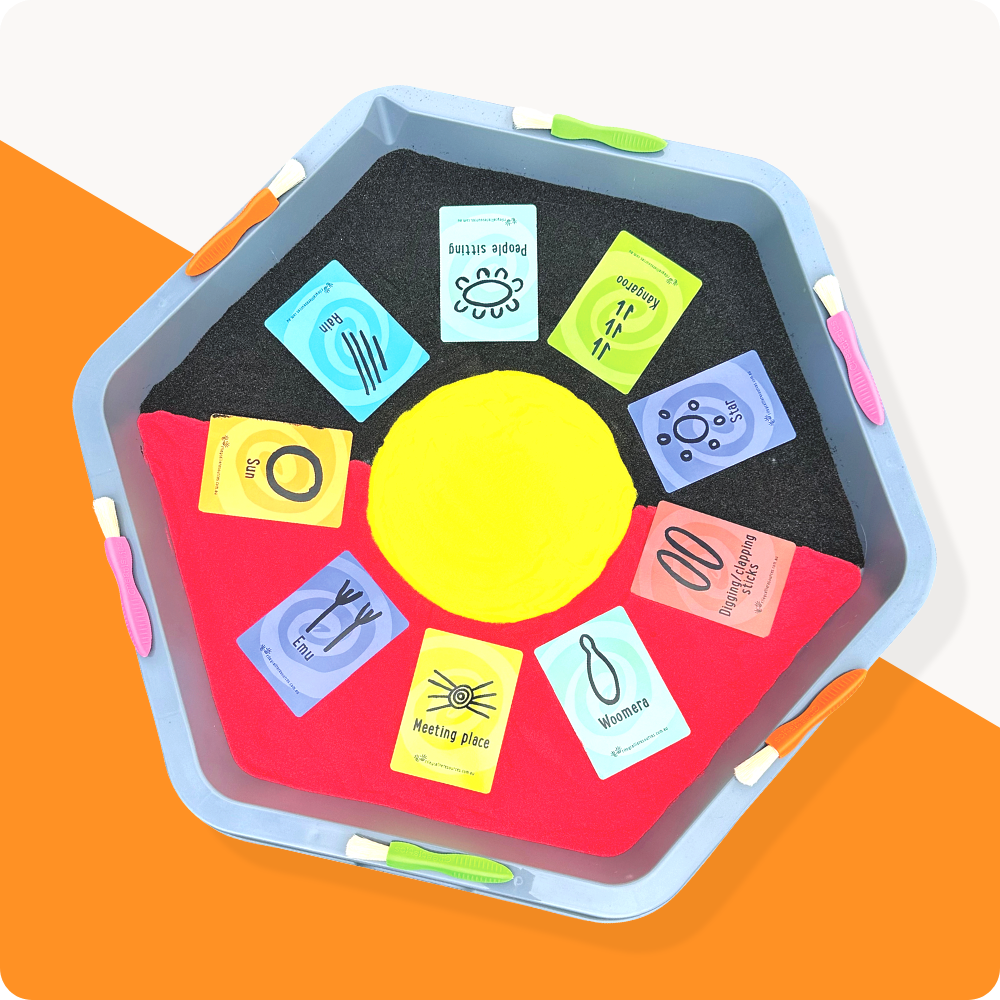
You’ll need:
Red, Yellow and Black sand (EC706, EC708, EC701)
Aboriginal Symbols Cards (RICA1302)
Let’s make it!
- Empty the 3 containers of coloured sand into your sensory tray and gently smooth out.
- Place an Aboriginal Symbols Card and Easi Grip Brush at each ‘station’ for children to recreate.
- Use the Easi Grip brushes (or fingers for tactile memory) to recreate the symbols.
- Enrich the experience using language. Talk about the symbols; what they look like (is the symbol created with wavy lines, circles, dots, curves etc.), what does each symbol represent (meeting place, water, animals etc.) Can you tell a story using the symbols? What symbols can you find in the learning environment? Done! You’re ready to explore.
TOP TIP – Younger children will benefit from the chunky barrel of the Easi Grip Brushes while older students will find a thinner brush more comfortable to handle.
And so over to you for tuff tray time! We’re so excited to know what activities you use your tray for to encourage sensory exploration, messy play and small world play in your centre. What’s your favourite activity? Which will you be trying first?

